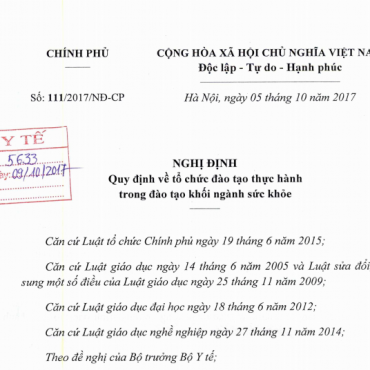Liên hệ tuyển sinh
Hợp tác Quốc tế
Association Between Dispatch of Mobile Stroke Units and Functional Outcomes Among Patients With Acute Ischemic Stroke in Berlin
February 2, 2021
Association Between Dispatch of Mobile Stroke Units and Functional Outcomes Among Patients With Acute Ischemic Stroke in Berlin
Martin Ebinger, MD1,2; Bob Siegerink, PhD1; Alexander Kunz, MD1,2; et alMatthias Wendt, MD3; Joachim E. Weber, MD4,8; Eugen Schwabauer, MD5; Frederik Geisler, MD4; Erik Freitag, MD4; Julia Lange, MD4; Janina Behrens, MD4; Hebun Erdur, MD4; Ramanan Ganeshan, MD4; Thomas Liman, MD4; Jan F. Scheitz, MD1,4; Ludwig Schlemm, MD1,4; Peter Harmel, MD4; Katja Zieschang, MD3; Irina Lorenz-Meyer, MSc4; Ira Napierkowski, Dr rer nat4; Carolin Waldschmidt, MD4,6; Christian H. Nolte, MD1,4,7,8; Ulrike Grittner, DrPhil7,9; Edzard Wiener, MD10; Georg Bohner, MD10; Darius G. Nabavi, MD5; Ingo Schmehl, MD3; Axel Ekkernkamp, MD3; Gerhard J. Jungehulsing, MD11; Bruno-Marcel Mackert, MD12; Andreas Hartmann, MD13; Jessica L. Rohmann, MScPH1,14; Matthias Endres, MD1,4,7,8,15,16; Heinrich J. Audebert, MD1,4; for the Berlin_PRehospital Or Usual Delivery in stroke care (B_PROUD) study group
JAMA. 2021;325(5):454-466. doi:10.1001/jama.2020.26345
Question Is the dispatch of mobile stroke units in the out-of-hospital setting before arriving at the hospital associated with better functional outcomes among patients with acute ischemic stroke eligible for thrombolysis or thrombectomy?
Findings In this prospective nonrandomized controlled intervention study involving 1543 patients in Berlin, Germany, the dispatch of mobile stroke units in addition to conventional ambulances vs conventional ambulances alone was significantly associated with lower levels of global disability at 3 months (common odds ratio for higher modified Rankin Scale scores [ie, worse outcome], 0.71).
Meaning Among patients with acute ischemic stroke in Berlin, Germany, dispatch of a mobile stroke unit was associated with lower global disability at 3 months; further research in diverse settings is needed.
Abstract
Importance Effects of thrombolysis in acute ischemic stroke are time-dependent. Ambulances that can administer thrombolysis (mobile stroke units [MSUs]) before arriving at the hospital have been shown to reduce time to treatment.
Objective To determine whether dispatch of MSUs is associated with better clinical outcomes for patients with acute ischemic stroke.
Design, Setting, and Participants This prospective, nonrandomized, controlled intervention study was conducted in Berlin, Germany, from February 1, 2017, to October 30, 2019. If an emergency call prompted suspicion of stroke, both a conventional ambulance and an MSU, when available, were dispatched. Functional outcomes of patients with final diagnosis of acute cerebral ischemia who were eligible for thrombolysis or thrombectomy were compared based on the initial dispatch (both MSU and conventional ambulance or conventional ambulance only).
Exposure Simultaneous dispatch of an MSU (computed tomographic scanning with or without angiography, point-of-care laboratory testing, and thrombolysis capabilities on board) and a conventional ambulance (n = 749) vs conventional ambulance alone (n = 794).
Main Outcomes and Measures The primary outcome was the distribution of modified Rankin Scale (mRS) scores (a disability score ranging from 0, no neurological deficits, to 6, death) at 3 months. The coprimary outcome was a 3-tier disability scale at 3 months (none to moderate disability; severe disability; death) with tier assignment based on mRS scores if available or place of residence if mRS scores were not available. Common odds ratios (ORs) were used to quantify the association between exposure and outcome; values less than 1.00 indicated a favorable shift in the mRS distribution and lower odds of higher levels of disability.
Results Of the 1543 patients (mean age, 74 years; 723 women [47%]) included in the adjusted primary analysis, 1337 (87%) had available mRS scores (primary outcome) and 1506 patients (98%) had available the 3-tier disability scale assessment (coprimary outcome). Patients with an MSU dispatched had lower median mRS scores at month 3 (1; interquartile range [IQR], 0-3) than did patients without an MSU dispatched (2; IQR, 0-3; common OR for worse mRS, 0.71; 95% CI, 0.58-0.86; P < .001). Similarly, patients with an MSU dispatched had lower 3-month coprimary disability scores: 586 patients (80.3%) had none to moderate disability; 92 (12.6%) had severe disability; and 52 (7.1%) had died vs patients without an MSU dispatched: 605 (78.0%) had none to moderate disability; 103 (13.3%) had severe disability; and 68 (8.8%) had died (common OR for worse functional outcome, 0.73, 95% CI, 0.54-0.99; P = .04).
Conclusions and Relevance In this prospective, nonrandomized, controlled intervention study of patients with acute ischemic stroke in Berlin, Germany, the dispatch of mobile stroke units, compared with conventional ambulances alone, was significantly associated with lower global disability at 3 months. Clinical trials in other regions are warranted.
Source: https://jamanetwork.com/journals/jama/article-abstract/2775714?guestAccessKey=9d095584-6bf0-418f-b528-c9d58e870386&utm_source=silverchair&utm_medium=email&utm_campaign=article_alert-jama&utm_content=etoc&utm_term=020221
Các tin khác
- Đơn trị liệu bằng Ticagrelor hoặc Clopidogrel và liệu pháp kháng tiểu cầu kép sau can thiệp mạch vành qua da ( 16:16 - 29/03/2024 )
- Effect of Endovascular Treatment Alone vs Intravenous Alteplase Plus Endovascular Treatment on Functional Independence in Patients With Acute Ischemic Stroke ( 15:26 - 20/05/2021 )
- Autoimmune Testing in Primary Care for Rheumatology Referrals ( 15:42 - 19/05/2021 )
- Chronic Kidney Disease: Laboratory Support of Diagnosis and Management ( 15:38 - 19/05/2021 )
- Screening for Asymptomatic Carotid Artery Stenosis: Recommendation Statement ( 15:52 - 18/05/2021 )
- Hypothyroidism: Diagnosis and Treatment ( 15:32 - 18/05/2021 )
- Molecular Diagnostic Yield of Exome Sequencing in Patients With Cerebral Palsy ( 13:49 - 18/05/2021 )
- Screening for Hypertension in Adults US Preventive Services Task Force Reaffirmation Recommendation Statement ( 14:46 - 15/05/2021 )














